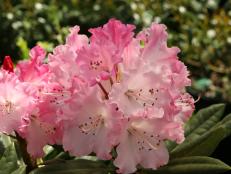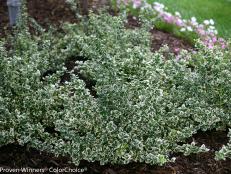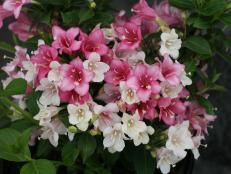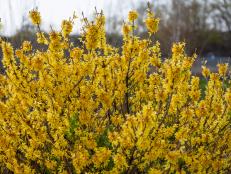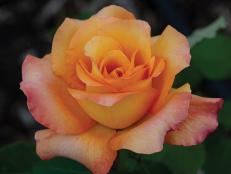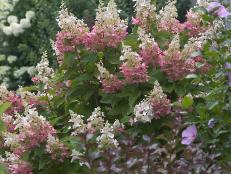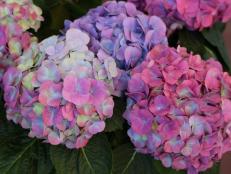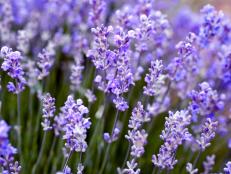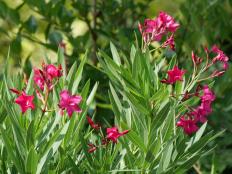How to Grow and Care for Red Twig Dogwood
Grow this easy-to-care-for shrub for both a winter accent and holiday décor.


In the dead of winter while the rest of the garden slumbers, colorful twig dogwoods light up the landscape with their graceful crimson, coral or golden stems. With compact, gold leafed and variegated selections on the market, there is a twig dogwood for any garden.

For many gardeners, the name "dogwood" brings to mind cascades of soft white and pink spring blooms that grace the branches of understory trees. These beloved spring beauties are related to another group of plants in the genus Cornus that look completely different in form and in flower.
Botanical Name: Cornus spp.
Common Name: Twig Dogwood (also referred to as the Cornus alba group)
Bloom Time: Spring
Light Needs: Full sun to part shade
Hardiness Zones: Depends on species
Height: Up to 15 feet, depending on the species
Growth Rate: Medium
Shrubby twig dogwoods are best known for their colorful winter stems. Right after the autumn leaves fall, vigorous new growth that was put on over the summer transforms to shades of stunning red, orange, coral or yellow.

In late summer and early fall, the twig dogwood shrub’s green leaves are complemented by stems that begin to take on their red color, which lasts through winter.
While twig dogwoods don't produce the showy petal-like bracts of the flowering dogwoods, these shrubs can put on a profusion of 1- to 2-1/2-inch-wide clusters of small white blooms for a week or so in early summer. These flowers develop into attractive white, blue or black fruits in the fall that birds can't resist.
Twig Dogwood Varieties
There are many species in this group, but the ones you're most likely to come across in the nursery are three common and visually similar Tartarian dogwood (C. alba), bloodtwig dogwood (C. sanguinea) and redosier dogwood (C. sericea).
Tartarian dogwood (C. alba) is an Asian species with a native range from Siberia to the Korean peninsula. The Tartarian dogwood is tolerant of cold temperatures to USDA Hardiness Zone 3, but it languishes in the summer heat often found in Zones 7 and up. This species usually grows between 6 and 10 feet tall and 5 to 8 feet wide, although there are more compact varieties on the market. The Tartarian dogwood is generally better behaved in the shrub border than many other species of twig dogwood. While the stem color varies throughout the year, this group is grown for its standout winter colors. The fall fruit are usually white or soft, powder blue.
Bloodtwig dogwood (C. sanguinea) is a European native, hardy in Zones 4 to 7 with better heat tolerance than C. alba or C. sericea. This species can grow from 8 to 15 feet tall with a spreading, suckering habit that form dense colonies. The common name "bloodtwig" was given because this is a twig dogwood that produces blood-red fall color, although there are varieties that produce stunning red stems. The black fruit is especially striking against the crimson fall foliage.
Redosier dogwood (C. sericea, formerly C. stolonifera) is native to North America and hardy in Zones 2 to 7. The straight species grows up to 9 feet tall with a suckering, colonizing habit, but there are smaller, better-behaved selections available. The creamy white fruit provides nice contrast against red autumn foliage (that is, if the foliage survives the summer). Redosier dogwood is usually more susceptible to disease pressures, like stem canker and leaf spot disease, in hot southern regions

Shutterstock/Carmen Hauser
The creamy white fruit of Cornus sericea.
Using Twig Dogwood in Your Landscape
Where to Plant Twig Dogwood
Choose a spot where your twig dogwood can shine out in the winter. Twig dogwoods should be planted in front of a contrasting backdrop to make a visual impact. The stunning stems of red twig dogwood will be much more noticeable if planted in front of a stone wall or an evergreen hedge (such as laurel, yew or arborvitae) rather than in front of a red brick wall.
Some varieties are well behaved in a small, residential garden setting. Compact selections work well as a single specimen plant. Most twig dogwoods demand room to roam and are best suited for use as a hedge, for streambank stabilization, roadside plantings, parks and golf courses. Twig dogwoods colonize rapidly, which means they don't play well when closely planted with less vigorous shrubs or herbaceous plants.
Choose a tough, adaptable, equally vigorous groundcover, like Pachysandra or sedge (Carex spp.), as a companion to grow below and between dogwood shrubs.
Twig Dogwood Care
Water
The first step in growing a healthy twig dogwood is proper planting. Keep an eye on water over the first growing season, and make sure plants receive about an inch of water from rain or irrigation each week.
Light Requirements
To make sure your stems develop strong color, ensure that they get plenty of sun. Choose a sunny spot that receives at least six hours of bright, direct light. The foliage of forms with variegated or golden leaves will be more attractive and longer lasting when grown in partial shade.
Soil
Twig dogwoods will tolerate a variety of soil conditions, but they are happiest in well-drained soil that has consistent moisture throughout the season.
Pruning
Twig dogwoods are known for their colorful winter stems, but the older growth is usually much less showy gray or brown. Keep your red twig dogwood dazzling and compact with annual pruning. Some gardeners selectively remove the oldest canes each season, completely pruning out stems that are larger than 3/4 inches in diameter. Others prefer to cut all the branches between 6 inches and a foot from the ground late in the winter.
Health Problems
Stressed, unhappy twig dogwoods that are languishing in excessively hot climates or drowning in poorly drained soils are more likely to have pest and disease problems. According to Michael Dirr's Manual of Woody Landscape Trees, twig dogwoods are susceptible to borers, scales, crown canker, leaf blight, leaf spots, powdery mildew, twig blight, root rot and many other health issues. A few of the most common health problems are highlighted here:
- Stem canker – The most serious disease of twig dogwoods, stem canker causes dark, sunken lesions on the stem and eventually stem dieback. To limit stem canker problems, avoid planting in heavy, poorly drained soils, provide consistent irrigation throughout the growing season, avoid over-fertilizing and cut back annually.
- Leaf spot anthracnose – This is more of an annoying aesthetic problem than a serious detriment to plant health. Symptoms are small lesions with a light center — the center may fall out of the spot later in the season. This is more common after moist and cool spring weather. According to Paul Cappiello and Don Shadow in Dogwoods: The Genus Cornus, treatment is not usually recommended.
- Septoria leaf spot – This ruins the appearance of foliage late in the summer or early in the fall but is usually more of an aesthetic problem than a serious health issue. Chemical treatments are not usually recommended. The best way to prevent Septoria leaf spot is to rake and remove fallen leaves at the end of the growing season as the disease overwinters in spent foliage on the ground.
- Dogwood sawfly – These caterpillar-like insects love to chew holes in the leaves of twig dogwoods. Feeding damage can be extensive, but it's usually short lived before the insects pupate into adults; plants usually recover fairly quickly, and sawfly larvae are an important food source for songbirds. Dr. Douglas Tallamy, the entomologist, environmentalist and the author of several books (including Bringing Nature Home and Nature's Best Hope), recommends practicing a 10-step program: "Take 10 steps back from the trunk and all your insect problems go away."
Popular Twig Dogwood Varieties
For Colorful Winter Stems
- C. alba 'Bloodgood' – very attractive, with vibrant red stems in the winter
- C. alba 'Bud's Yellow' – eye-catching yellow stems in the winter, buttery yellow fall color
- C. alba 'Siberica' – probably the most popular variety of Cornus alba on the market; unfortunately, plants labeled as 'Siberica' may actually be C. baileyi, C. sericea, or C. amomum, which means the specimen you plant may not perform up to expectations
- C. sanguinea 'Cardinal' – bright, cherry red winter stems; leaves somewhat resistant to leaf spot
- C. sanguinea 'Midwinter Fire' – showstopping winter color with brilliant stems that actually do look similar to a fire; golden yellow near ground-level, becoming more orange, then bright red at the tips; can also have lovely buttery yellow fall foliage; readily spreads by suckering
- C. sanguinea 'Winter Beauty' – very similar to 'Midwinter Fire,' differs in slightly more red-tone to winter stems and less vigorous suckering
- C. sericea 'Baileyi' – Bailey red twig dogwood was once considered its own species but is now considered a form of C. sericea, attractive maroon fall foliage with red-brown winter stems
- C. sericea 'Bud's Yellow' – bright yellow winter stem color, less aggressive suckering than the species, grows up to 6 feet tall
- C. sericea 'Flamivera' – golden winter stems with lustrous, glossy green foliage during the growing season
For Dazzling Foliage
- C. alba 'Argenteo-marginata' – variegated white and green foliage shines out in the garden during the growing season, wine red winter stems, may be incorrectly labelled as C. alba 'Elegantissima' or C. elegantissima
- C. alba 'Aurea' – chartreuse foliage with vivid red stems, golden fall color if the leaves survive through to autumn, demands consistent soil moisture throughout the summer, site in partial shade for best results
- C. alba Summer Dreams™ – green leaves surrounded by a white margin, deep red fall color, brilliant winter stems, 4 to 6 feet tall by 4 to 8 feet wide
- C. sericea 'Hedgerow's Gold' – golden margins surround green leaf centers, highly susceptible to leaf spot disease
- C. sericea 'Silver and Gold' – silver leaf margins surround green centers, attractive golden winter stems, plant in well-drained soils to limit canker disease
- C. sericea 'Sunshine' – show-stopping chartreuse foliage that will illuminate any garden, performs better in the Pacific Northwest than the rest of the country
For Small Spaces
- C. alba 'Allemen's Compact' – more compact form than the species, reaching only 5 feet tall, red stems, foliage resistant to leaf spot
- C. alba Chief Bloodgood – compact form reaches 6 feet in height, produces attractive coral winters stems
- C. alba Ivory Halo – this compact form maxes out at 6 feet tall, finer textured than the species, white leaf margins surround soft gray-green centers, susceptible to leaf spot
- C. alba Red Gnome – a more compact form that should only reach 3 feet in height, produces finer textured stems than the species, vivid coral red winter stems with wine-red fall color
- C. sanguinea 'Arctic Sun' – fiery orange-red tips fading to golden yellow near the base, grows up to 4 feet tall by 4 feet wide
- C. sanguinea 'Compressa' – this variety is barely recognizable as C. sanguinea; a polarizing plant, beloved by some who love the unique form, hated by others who think it's just ugly; semi-evergreen in warm, southern climates; crinkled, lustrous green, quarter-sized leaves closely spaced along the stem; will eventually reach 8 feet tall with a spread of only 1 foot wide; tight, columnar habit reminiscent of a 'Sky Pencil' holly
- C. sericea 'Arctic Fire' – deep red stems, grows up to 4 feet high with an equal spread
- C. sericea 'Kelseyi' – an extremely compact selection, growing up to 30 inches in height, may not produce as colorful stems or fall foliage as the species
Other Native Species
- Silky dogwood (C. amomum) – native to eastern North America from Massachusetts to Georgia and west to Tennessee, hardy in Zones 4 to 8 with fantastic drought and heat tolerance, young stems are green with a purple hue but mature growth is gray or brown, cut back annually to promote more colorful winter stems, when not cut back regularly, will grow up to 12 feet tall with suckering habit, porcelain blue berries
- Roughleaf dogwood (C. asperifolia) – native to eastern North America with a slightly larger range than C. amomum, young stems are green with purple hue and may hold color longer than C. amomum
- Western cornel (C. glabrata) – native to western North America, grows up to 15 feet in height with suckering habit, attractive powder blue or white fruits
- Gray dogwood (C. racemosa) – native to eastern North America; hardy in zones 7 to 9, although given the right conditions could tolerate lower winter temperatures; grows up to 15 feet tall with sprawling, suckering habit; adaptable to most environmental conditions
- Black fruited dogwood (C. sessilis) – native to northern California, grows up to 12 feet tall, green new growth, attractive wine-red fall foliage, shiny black fruit






